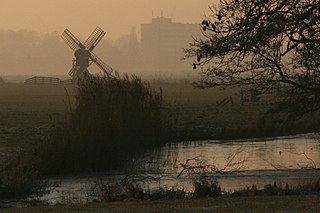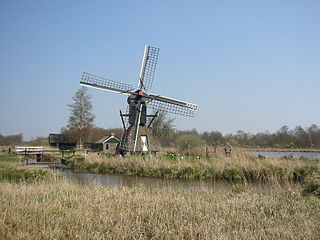
Arkens is a Hollow Post mill in Franeker, Friesland, Netherlands which has been restored to working order. The mill is listed as a Rijksmonument, number 15710.

Heechheim is a Hollow Post mill in Goëngahuizen, Friesland, Netherlands which has been restored to working order. The mill is listed as a Rijksmonument, number 33999.

De Oegekloostermolen is a hollow post mill in Hartwerd, Friesland, Netherlands which was built before 1830. The mill has been restored to working order. It is listed as a Rijksmonument, number 39347.

The Terpensmole is a drainage mill in IJlst, Friesland, Netherlands. It was moved from its earlier location in Sneek in 2011 where it was known as the Himmole. The mill is listed as a Rijksmonument, number 22914. It is fully functional and can be used to help drain the adjacent polder.

Terpzigt is a drainage mill in Marssum, Friesland, Netherlands. It is the smallest spinnenkop, a type of hollow post windmill. The mill is listed as a Rijksmonument, number 8625.

The Monnikenburenmolen or Nijhuizumermolen is a drainage mill in Nijhuizum, Friesland, Netherlands. It was restored in 2008 after it was only just saved from demolishment in 1994. It is a hollow post windmill of a type called "spinnenkop" by the Dutch. The mill is listed as a Rijksmonument, number 527646. It can help drain the polder and has been designated as a backup to the pumping station by the waterboard Wetterskip Fryslân.

The Geeuwpoldermolen is a drainage mill near the twin village of Oppenhuizen, Friesland, Netherlands. It is a hollow post windmill of the type called spinnenkop by the Dutch. The mill is listed as a Rijksmonument, number 39810 and it is still in use for draining the Geeuwpolder. It was almost completely renewed at a restoration in 1987, earlier restorations were in 1954 and 1965.

Doris Mooltsje is a drainage mill near the village of Oudega, Friesland, Netherlands. It is a hollow post windmill of the type called spinnenkop by the Dutch. The mill is listed as a Rijksmonument, number 527647 and has been restored to working order in 1998.

The Himriksmole, also known as Groene Ster after the recreational area and nature reserve where it is located, is a drainage mill near the village of Tytsjerk, Friesland, Netherlands. It is a hollow post windmill of the type called spinnenkop by the Dutch. The mill is listed as a Rijksmonument, number 35675, and is used to raise the water level in the nature reserve.

Teetlum, after a nearby terp, also known as Duivenhok 'dove coat' named after the polder it drained, is a drainage mill near the village of Tzum, Friesland, Netherlands. It is a hollow post windmill of the type called spinnenkop by the Dutch. The mill is listed as a Rijksmonument, number 15877 and can be used to drain the adjacent polder.

Fatum is a drainage mill near the village of Tzum, Friesland, Netherlands. It is a hollow post windmill of the type called "spinnenkop" by the Dutch. The mill is listed as a Rijksmonument, number 15876 and is in working order though it can no longer be used for drainage.

Spinnenkop Wedderveer is a wind powered sawmill in the village of Wedderveer, Groningen, Netherlands. It is a hollow post windmill of the type called "spinnenkop" by the Dutch built on top of a brick shed. The mill is listed as a Rijksmonument, number 388083 and is in working order.

De Wicher is a drainage mill near the village of Kalenberg, Overijssel, Netherlands. It is a hollow post windmill of the type called spinnenkop by the Dutch. The mill is in working order and used to drain the reed beds during winter to improve accessibility for reed cutters.

Mijn Genoegen is a paltrok mill in the Netherlands Open Air Museum in Arnhem, Gelderland, Netherlands which has been restored to working order. As are all Dutch paltrok mills, it is a wind-powered sawmill.

Huizermolen is a post mill in the Netherlands Open Air Museum, Arnhem, Gelderland, Netherlands which was built in 1919 and is in working order.

The smock mill at the Netherlands Open Air Museum, Arnhem, Gelderland, Netherlands was originally built at Noordlaren, Groningen, Netherlands in 1862. It was dismantled in 1953 and re-erected at the museum in 1960. The mill has been restored to working order.

De Hoop is a tower mill in Arnhem, Gelderland, Netherlands which was built in 1846 and is in working order. The mill is listed as a Rijksmonument.

Het Fortuyn is a tower mill in the Netherlands Open Air Museum, Arnhem, Gelderland, Netherlands which was built in 1920 and is in working order.

A hollow post mill at the Netherlands Open Air Museum, Arnhem, Gelderland, Netherlands was originally built at Gouda, South Holland, Netherlands. It was dismantled in 1946 and re-erected at the museum. The mill has been restored to working order.

A hollow post mill at the Netherlands Open Air Museum, Arnhem, Gelderland, Netherlands was originally built at Wormer, North Holland, Netherlands. During World War I, it was moved to Langweer, Friesland. It was dismantled in 1960 and re-erected at the museum in 1989. The mill has been restored to working order.





















